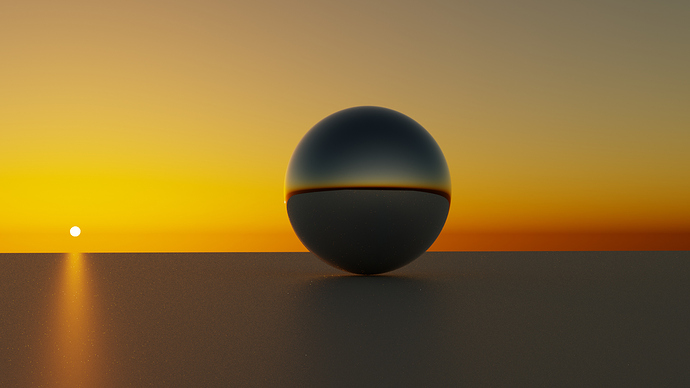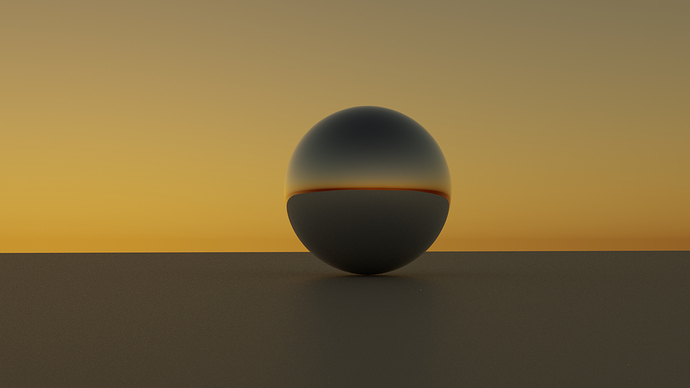… Man… I was thinking that it would be compatible with Eevee… 
… back to Real Sky.
@nacioss thx! Eager to see some speed test for 11,21 and 81 when multithreaded. Does 81 slow down render process or only precomputation time?
The more wavelengths sampled the more precomputation time, no impact on render time though, but it’s good to keep sampling wavelengths relatively low
Ok sounds good then, thx! Hope multithreading will allow better quality. I know I’m quality biased, but if it’s 1-2 seconds more on modern hardware then it’s good trade-off if it saves time spent on post.
Question about direct sun lamp: do you plan to patch sun lamp to add possibility to see it directly? It would be possible then to easely do sunstars and bloom in post.
Not sure what you mean but if you are referring to the sun disc then it’s already visible. Lukas and me are now discussing how to approach the lighting issue (but mainly the problem is due to how Multiple Importance Sampling works)
I hope you can work together on this and come to an agreement. Thanks!
I meant direct sun lamp, not sun disc from sky. It casts shadows, it is possible to see it in reflection/refraction but It’s not visible directly or maybe I’m missing something…
That’s more of a cycles light issue than something that should really be addressed here. As far as I know no lights in Cycles are directly visible. It seems odd to me that there isn’t at least a toggle for this (unless there is and I’ve missed it this whole time) but that’s definitely a separate issue to the new sky model.
Sure, I agree. I’ve mentioned this as I thought it might be useful/related info.
Here are some tests i did.
3 vs 81 wavelengths:
https://drive.google.com/drive/folders/17159JCwhoE3qAczPTY_cmKVHibcF0VxB?usp=sharing
6 vs 81 wavelengths:
https://drive.google.com/drive/folders/1tfWzkJeJRD96mAIQhKn5GEADL5Z8bpqW?usp=sharing
11 vs 81 wavelengths:
https://drive.google.com/drive/folders/127zN5PhBeJW09K6ppNZ9ChKRw-p7Ye40?usp=sharing
21 vs 81 wavelengths:
https://drive.google.com/drive/folders/1BD7RPulkt97rAxkvMbjAIQFWB0UC84ro?usp=sharing
41 vs 81 wavelengths:
https://drive.google.com/drive/folders/1aPaEnf3giT8pA147nPTsaH0xn3B_PeqH?usp=sharing
Wow thank you! I tried to look carefully and then subtracted to see what I get. Looks like:
11 - visible
21 - not visible but measurable: it gives differences of 0-1/256 mainly on blue and red channels
41 - I’d say it’s barely measurable (in 8 bit)
PNGs after subtract and curves adjustment in Krita:



Thank you for showing the differences. Then for sure we will switch to 21 wavelengths 
As far as I know Indigo dev switched wavelength sampling from 16 to 32 currently, but not sure if this is related: https://www.indigorenderer.com/forum/viewtopic.php?f=1&t=15464
He uses multiscattering model though.
Wishful thinking but aurorae would be sweet(but way too much to ask).
Probably. But not impossible. I hate to pollute this thread with such off-topic dreaming, but it is still fun to think about.
Could be wrong, but I think the method in this thread can only simulate the day until the Sun is 3 or 4 degrees below the horizon. But the color of the night sky can also be simulated, with the sun contributing to some of the sky color through twilight until about 18 degrees below horizon. And the Moon’s contribution to nighttime Illuminance is known. So a sky texture could theoretically work for an entire day cycle. Then add a Moon image and normal map, and then stars too.
Dreamings aside (please don’t ask feature requests now that the model is quite implemented in Blender).
Here is a comparison between Hosek/Wilkie and this model:
Nishita (ours) took 1 min 48 sec to render:
Hosek / Wilkie… guess what ![]() took 2 min 03 sec to render:
took 2 min 03 sec to render:

To be clear it wasn’t a serious request. Something like it would probably be better off as a separate shader/texture node itself.
Switched from 11 to 21 sampled wavelengths!
There seems to be no visible slowdowns.
Talked with Bruneton a bit and it turns out i’ve used the wrong math for the Ozone Absorption for all of this time! Now i’m fixing it, but from the first tests it seems like the sky now is much better!!
Before:

After:

Notice how the energy conservation in the first is totally off ![]()
This is probably not the best test, but i can tell you that the sky is much bluer in some sun elevations

